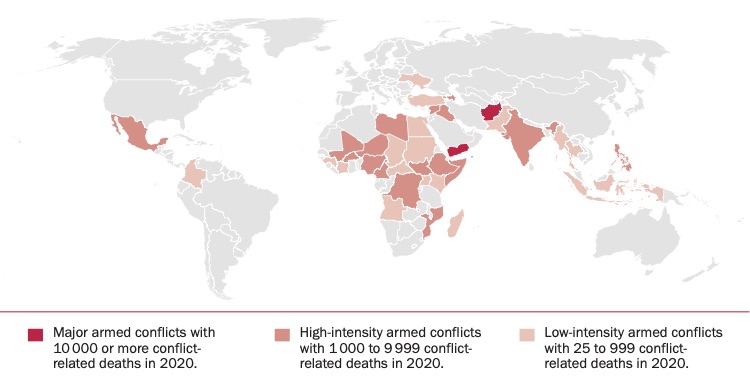2. Global developments in armed conflicts, peace processes and peace operations
Active armed conflicts occurred in at least 39 states in 2020 (5 more than in 2019): 2 in the Americas, 7 in Asia and Oceania, 3 in Europe, 7 in the Middle East and North Africa (MENA) and 20 in sub-Saharan Africa. As in preceding years, most took place within a single country (intrastate), between government forces and one or more armed non-state group(s). Two intrastate conflicts were major armed conflicts (with more than 10 000 conflict-related deaths in the year)—Afghanistan and Yemen—and 16 were high-intensity armed conflicts (with 1000–9999 conflict-related deaths)—Mexico, Syria, Nigeria, the Democratic Republic of the Congo, Ethiopia, Somalia, Mali, Iraq, South Sudan, Burkina Faso, Mozambique, Cameroon, Libya, the Philippines, India and Niger. Only two armed conflicts were fought between states: the ongoing border clashes between India and Pakistan, and the border conflict between Armenia and Azerbaijan for control of Nagorno-Karabakh, which escalated into a high-intensity conflict. Two other armed conflicts were fought between state forces and armed groups that aspired to statehood (between Israel and the Palestinians and between Turkey and the Kurds).
Armed conflicts in 2020

Consequences of armed conflict
For at least the second consecutive year the total estimated number of conflict-related fatalities decreased. The total in 2020 was approximately 120 000—a 30 per cent reduction since 2018. The decrease in 2020 was largely driven by reductions in conflict-related fatalities in Asia and Oceania, and MENA. Two regions bucked this trend: Europe, because of the armed conflict between Armenia and Azerbaijan; and sub-Saharan Africa (see Conflict-related Fatality Estimates in sub-Saharan Africa). While conflict-related fatalities have declined in recent years, other negative impacts of armed conflict (sometimes in combination with other factors) appear to have increased in severity, including population displacement, food insecurity, humanitarian needs, and violations of international humanitarian law.
Peace agreements and the impact of Covid-19
While many peace processes either stalled or suffered serious setbacks during 2020, important advances were made in the
peace talks in Afghanistan. In addition, the ceasefires in Libya and Syria suggested that both of those conflicts might be moving towards some form of resolution in the near to medium term. A Russian-brokered ceasefire ended the fighting in Nagorno-Karabakh. However, in sub-Saharan Africa, the peace process in Sudan was the only one to make substantive progress in 2020.
The impact of Covid-19 on armed conflicts in 2020 was mixed: there were some temporary declines in armed violence, but the intensity of violence generally stayed at the same level and in some cases increased.
Trends in multilateral peace operations
There were 62 active multilateral peace operations in 2020; one more than the previous year. Three operations ended in 2020: the Economic Community of West African States Mission in Guinea-Bissau (ECOMIB); the African Union (AU)–United Nations Hybrid Operation in Darfur (UNAMID); and the UN Integrated Peacebuilding Office in Guinea-Bissau (UNIOGBIS). Three operations started in 2020: the AU Military Observers Mission to the Central African Republic (CAR)(MOUACA), the European Union (EU) Common Security and Defence Policy Advisory Mission in CAR (EUAM RCA) and the AU Mission in Libya.
The number of personnel deployed in multilateral peace operations decreased by 7.7 per cent during 2020, to reach 127 124 on 31 December 2020. This was mainly driven by reductions in some large multilateral peace operations, especially the Resolute Support Mission (RSM) in Afghanistan. The UN remains the leading organization in the field, with responsibility for about one-third of all multilateral peace operations and two-thirds of all personnel.
In 2020 the AU Mission in Somalia (AMISOM) continued to be the largest multilateral peace operation, despite further force reductions. Ethiopia remained the top troop contributor, followed by Uganda and Bangladesh.
In 2020 the annual fatality rate for hostile deaths of uniformed personnel in UN peace operations was the lowest in the decade 2011–20. However, the fatality rate for deaths from all causes was higher than in previous years because of a significant increase in the number of deaths due to illness, including Covid-19.
The number of operations that are not ‘multilateral peace operations’ (as defined by SIPRI) continued to increase, with three new deployments in 2020: a Russian ‘peacekeeping contingent’ in Nagorno-Karabakh; the EU Naval Force Mediterranean Operation Irini; and the European multinational Task Force Takuba in the Sahel.